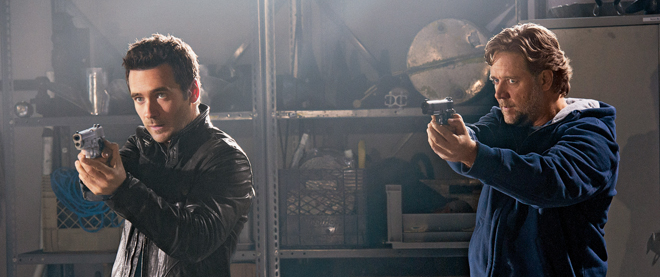How do Canadian networks sustain a smash TV hit?
Aggressive promotion, Twitter and stunt casting, like Russell Crowe, certainly helps
CBC
Share

Who says Canadians won’t watch CanCon? The CBC got over a million viewers (a good number in a country of 33 million) for its recent premieres of the adventure series Arctic Air and the comedy Mr. D, while the miniseries Bomb Girls did so well for Global that it was turned into a continuing series. These strong premieres are due to aggressive promotion, something that doesn’t always happen in English-language Canadian TV. “CBC gets it,” says Arctic Air director-producer Gary Harvey. “They understand how to move the machine.” He means the publicity machine, and the question is what happens to these shows when it stops.
Original TV shows in Canada have traditionally been an afterthought, and to some extent they still are. Critic Bill Brioux, who posts ratings information for Canadian shows on his blog, says producers often ask him, “how did we do last night?”—because the networks don’t bother to tell them. But Canadian networks, realizing there are markets the U.S. networks aren’t serving, have started to push their product a little harder. Harvey says whereas it used to be hard to get a press release quoting favourable reviews, the CBC pushed its winter lineup with “billboards, TV, magazines, movie theatre promos, street promo, the premiere launch. It was awesome.”
But though a promotional blitz can help a show get an audience, it can’t hold it. Even U.S. shows aren’t immune to this phenomenon, with shows like Smash hemorrhaging viewers after a big first week. In Canada, things are even more precarious because the U.S. competition is so strong. “I’m amused every year when CBC puts up the Mission Accomplished sign after three weeks in January,” Brioux says, pointing out that U.S. shows were largely in reruns in January and “you’re not really going against the brunt of the import competition.” CBC shows launched last September, like Michael: Tuesdays and Thursdays, got clobbered. Even hits lose audiences when the promotion dies down: Little Mosque On the Prairie’s first week got almost twice as many viewers as it’s ever had since.
That means Canadian networks and producers alike have to figure out how to keep us hooked after the initial publicity blitz is over. One method is to rely on the powers of the Internet. “I do consider it part of my job,” Harvey says of promoting the show on social media such as Twitter and especially Facebook. Gabriela Schonbach, executive producer at Arctic Air’s studio, Omni Productions, says it is a way to keep the interest up in the second half of a season, when viewers may drift away. “I don’t think in the first part of the season you’re going to build your viewership through social media, but it does build.” Catherine Winkler, from the Vancouver publicity firm Switch United, told strategyonline.ca that the point of Internet and interactive initiatives for a TV show is “as a build for multiple seasons,” keeping the viewers engaged for more than the first week.
But even in a new media era, Canadian shows may need to put some faith in more traditional methods. Stunt casting, for instance. Harvey says “big event stories and stunt casting is a very useful tool in the promo arsenal. I’ve done it in the past and seen it work.” Republic of Doyle, a detective drama starring Allan Hawco as a Newfoundland PI, launched its third season by bringing in Russell Crowe as a special guest star, and Brioux says the show has had “over a million viewers five weeks in a row.”
In the end, though, the most important thing is making sure people want to watch, and some Canadian shows may catch on simply because they reach an audience U.S. networks aren’t serving. Brioux points out that Bomb Girls, despite lukewarm reviews, proved very popular with older viewers, who like other nostalgia dramas such as Downton Abbey. One of the most popular of the CBC shows, Heartland, is an old-fashioned family drama that U.S. producers rarely make anymore. “After we get the initial audience to tune in,” Harvey says, “it’s really up to the show to take it from there.” That makes Canadian TV sound like something it hasn’t always been in the past: a real business.